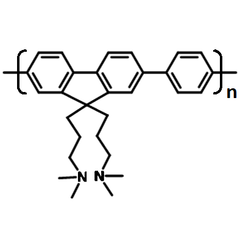PFN-FP
CAS Number 673474-79-8
Cathode Interlayer Materials (CIMs), Interface Polymers, Materials, Organic Conductors, Perovskite Interface Materials, Perovskite Materials, Semiconducting Polymers
PFN-FP, used to improve extraction efficiencies in OPV devices
High quality polymer available for fast, secure dispatch
Overview | Specifications | MSDS | Pricing and Options | Literature and Reviews
PFN-FP (CAS number 673474-79-8) is one of the family members of conjugated poly-electrolyte materials (such as PFN) which is used as an electron-interface layer material in OPV devices (including perovskite solar cells) to improve extraction efficiencies. PFN-FP is also used as an active-layer material for blue OLED devices.
PFN-FP is soluble in polar solvents (such as water and methanol) in the presence of small amounts of acetic acid.
Cathode interlayer molecule
For high efficient OPV applications
Improve extraction efficiency
as a conjugated polyelectrolyte
Worldwide shipping
Quick and reliable shipping
Good solubility
Soluble in polar solvents with small amount of acetic acid
General Information
| Full name | Poly[(9,9-bis(3'-(N,N-dimethylamino)propyl)-2,7-fluorene)-alt-1,4-phenylene] |
| Synonyms | PFN-B |
| Chemical formula | (C29H34N2)n |
| Absorption (in film) | λmax 398 nm |
| CAS number | 673474-79-8 |
| HOMO/LUMO | HOMO = -5.70 eV, LUMO = -2.12 eV [1] |
| Classification/Family | Conjugated polymers, Polymer electrolyte, Polyfluorenes, Electron interface-layer materials, OLED, OPV, Perovskite materials |
Chemical Structure

MSDS Documentation
Pricing
| Batch | Quantity | Price |
| M2078A1 | 100 mg | £280 |
| M2078A1 | 250 mg | £560 |
| M2078A1 | 500 mg | £900 |
Literature and References
- Novel Electroluminescent Conjugated Polyelectrolytes Based on Polyfluorene, F. Huang et al., Chem. Mater.,16, 708-716 (2004); DOI: 10.1021/cm034650o.
- Approaches Toward Efficient and Stable Electron Extraction Contact in Organic Photovoltaic Cells: Inspiration from Organic Light-Emitting Diodes, T-W. Lee et al., Elec Mater. Lett., 6 (1), 41-50 (2010); DOI: 10.3365/eml.2010.03.041.
- Combination of Titanium Oxide and a Conjugated Polyelectrolyte for High-Performance Inverted-Type Organic Optoelectronic Devices, H. Choi et al., Adv. Mater., 23, 2759–2763 (2011); DOI: 10.1002/adma.201100266.

 PFN-FP MSDS sheet
PFN-FP MSDS sheet